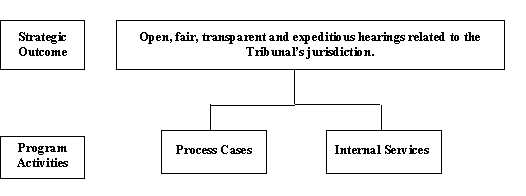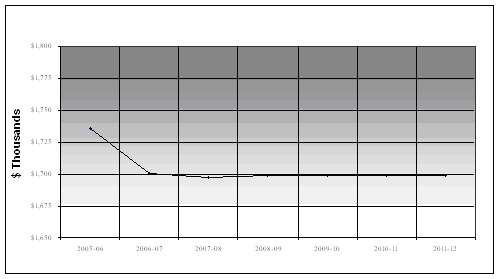ARCHIVED - Registry of the Competition Tribunal
 This page has been archived.
This page has been archived.
Archived Content
Information identified as archived on the Web is for reference, research or recordkeeping purposes. It has not been altered or updated after the date of archiving. Web pages that are archived on the Web are not subject to the Government of Canada Web Standards. As per the Communications Policy of the Government of Canada, you can request alternate formats on the "Contact Us" page.
2009-10
Report on Plans and Priorities
Registry of the Competition Tribunal
The original version was signed by
The Honourable Tony Clement
Minister of Industry
Table of Contents
- Financial Resources
- Human Resources
- Contribution of Priorities to Strategic Outcome
- Risk Analysis
- Expenditure Profile

Tony Clement
Minister of Industry
SECTION I - OVERVIEW
Summary Information
Raison d'être
The Competition Tribunal is a quasi-judicial adjudicative tribunal whose sole purpose and raison d’être is to hear and decide all applications related to civil reviewable matters set out in Part VII.1 (deceptive marketing practices) and Part VIII (restrictive trade practices) of the Competition Act. The purpose of this legislation is to maintain and encourage competition in Canada and to provide a fair and secure marketplace for Canadians. The Tribunal operates at arm’s length from government and its departments. The Competition Tribunal Act that establishes the Tribunal also provides for the Registry of the Competition Tribunal an administrative infrastructure to support the proper conduct of the business of the Tribunal.Responsabilities
The Registry of the Competition Tribunal is designated a department under the Financial Administration Act. It supports all aspects of the Tribunal’s work and ensures the Tribunal can hold hearings anywhere in Canada, as necessary. Registry headquarter is located in the National Capital Region. Parties to Tribunal cases file applications and documents with the Registry, which also issues documents and orders for all cases brought before the Tribunal. This Report on Plans and Priorities pertains to the activities of the Registry in support of the Tribunal and its deliberations, and not to Tribunal cases themselves.
Since its creation in 1986, the Tribunal has heard cases relating to mergers, abuse of dominant position and various trade practices that have involved key players in several industries. Cases have involved a number of business arenas, including pharmacies; furniture stores; importers of cast iron pipes; airline computer reservation systems; oil refining and gasoline retailing; community newspapers; aspartame; waste disposal; car parts; marketing research services; green handling services; weight loss products and fuel saving devices.
Strategic Outcome and Program Activity Architecture
The chart below illustrates the Registry of the Competition Tribunal’s framework for how its program activities contribute to progress toward its strategic outcome.

Planning Summary
| 2009-10 | 2010-11 | 2011-12 |
|---|---|---|
| $2,012 | $2,012 | $2,012 |
The financial resources table provides a summary of the total planned spending for the Registry of the Competition Tribunal for the next three fiscal years.
| 2009-10 | 2010-11 | 2011-12 |
|---|---|---|
| 14 | 14 | 14 |
The human resources table above provides a summary of the total planned human resources for the Registry of the Competition Tribunal for the next three fiscal years.
| Performance Indicators | Targets |
|---|---|
| Client level of satisfaction regarding quality of service. | 80% satisfaction. |
| Tribunal members’ level of satisfaction regarding quality of service. | 80% satisfaction. |
| Program Activity | Forecast Spending 2008-09 ($ Thousands) |
Planned Spending ($ Thousands) |
Alignment to Government of Canada Outcomes | ||
|---|---|---|---|---|---|
| 2009-10 | 2010-11 | 2011-12 | |||
| Process Cases | $1,328 | $1,641 | $1,641 | $1,641 | A fair and secure marketplace |
| Internal Services | $371 | $371 | $371 | $371 | |
| Total | $1,699 | $2,012 | $2,012 | $2,012 | |
| Total Planned Spending | $2,012 | $2,012 | $2,012 | ||
Contribution of Priorities to Strategic Outcome(s)
| Operational Priorities | Type | Links to Strategic Outcome(s) | Description |
|---|---|---|---|
| Review the e-filing services offered to the parties | New | Open, fair, transparent and expeditious hearings related to the Tribunal’s jurisdiction. | Why is this a priority? Electronic filing of documents is a prerequisite to electronic hearings. Electronic hearings expedite the hearing process. Plans for meeting this priority? The Registry will review the current system, identify improvements and develop an implementation schedule |
| Implement digital recording for Tribunal hearings | New | Open, fair, transparent and expeditious hearings related to the Tribunal’s jurisdiction | Why is this a priority? Digital recording technology provides opportunities to easily play back audio files therefore eliminating the waiting period for transcriptions. Plans for meeting this priority? The Registry will test the selected technology in parallel with the existing system and develop an implementation plan. |
| Develop an Information Technology Asset Management Lifecycle | New | Open, fair, transparent and expeditious hearings related to the Tribunal’s jurisdiction | Why is this a priority? The public depends heavily on a reliable, up-to-date and secure technology platform to file documents with the Tribunal. Plans for meeting this priority? The Registry will evaluate the current equipment, identify the requirements of the public and parties, and invest in bridging the gap between the two. |
Risk Analysis
The Registry of the Competition Tribunal has an ongoing major planning challenge in that the Tribunal's sole function is to respond to the matters referred to it. As such, the Registry’s activities are driven by external demands that it can only react to rather than plan for. The number of applications brought to the Tribunal depends on the enforcement policy adopted by the Competition Bureau and the number of applications filed by individuals or companies under the private access provisions of the Competition Act. .
The main challenge of the Registry is to manage its resources to continue to deliver on mandate related activities. In the recent years, the Registry has either exceeded its budget or was in a break-even situation. Even if the demand for Registry services has remained relatively stable, the Registry has had to manage ongoing increases in operating costs, such as the per diem for members, travel charges, information technology upgrades and translation costs, while its funding budget has remained stable.
In July 2007, the Competition Policy Review Panel was mandated to review Canada’s competition and foreign investment policies, and recommend ways to improve Canada’s productivity and competitiveness. The Review Panel’s report, released in June 2008, puts forward a number of policy recommendations, some of which could increase the jurisdiction of the Tribunal. It is too early to assess what impact these recommendations could have on the workload of the Tribunal. The Registry will monitor these potential changes closely.
Another potential risk is the need for the Registry to manage its human resource requirements so as to deliver on mandate-related and support activities. As a micro-agency, the Registry can offer only limited development opportunities within its organization and so has experienced a high turnover in recent years.
Expenditure Profile
Departmental Spending Trend

The Registry’s reference level has not increased since the Tribunal’s inception in 1986, even when the jurisdiction of the Tribunal was expanded in 2002. Expenditures have hovered around the budget of $1,699,000. The spending trend will be expected to increase slightly should the jurisdiction of the Tribunal be expanded as proposed in Bill C-10. The Registry cannot forecast the Tribunal’s workload; it can only react and process cases brought forth by Canadian enterprises and the Competition Bureau.
| Vote # or Statutory Item (S) | Truncated Vote or Statutory Wording | 2008-09 Main Estimates |
2009-10 Main Estimates |
|---|---|---|---|
| 1 | Operating expenditures | $1,546 | $1,861 |
| (S) | Contributions to employee benefit plans | $153 | $151 |
| Total | $1,699 | $2,012 | |
Section II: Analysis of Program Activities by Strategic Outcome
Strategic Outcome
| Open, fair, transparent and expeditious hearings related to the Tribunal’s jurisdiction. |
The Tribunal hears applications and issues orders related to civil reviewable matters as set out in the Competition Act. These include deceptive marketing practices (part VII.1) and restrictive trade practices (part VIII).
Parties to the Competition Tribunal are mainly the Competition Bureau and Canadian businesses involved in a range of products and services. The cases it hears are complex and the impact of the decisions of the Tribunal on Canadian Businesses can be significant. The Registry provides efficient and effective support to the Tribunal in processing cases. The level of satisfaction of members and clients are measured at the conclusion of each hearing. A minimum of 80% satisfaction level has been set as a target.
The following section describes the Registry’s two program activities and identifies the expected result, performance indicators and targets for both of them.
Program Activity: Process cases
| Program Activity Expected Results | Performance Indicators | Targets |
|---|---|---|
| Timely Registry services that provide the public efficient access to case records and decisions. | Percentage of case documents and decisions posted on website within 48 hours of filing. | 90% |
| Documents are processed according to timeframes established in the Rules of Procedure. | Documents processed within established timeframes. | 100%. |
| Efficient access to electronic hearings of applications. | Percentage increase in use of electronic hearings. | 25% |
Embedded link to the descriptions to the Main estimates online will be added.
| Financial Resources ($ thousands) | Human Resources (FTEs) | |||||
|---|---|---|---|---|---|---|
| 2009-10 | 2010-11 | 2011-12 | 2009-10 | 2010-11 | 2011-12 | |
| $1,641 | $1,641 | $1,641 | 10 | 10 | 10 | |
Embedded link to the descriptions to the Main estimates online will be added.
This program activity includes the provision of all administrative support required for the proper conduct of the Competition Tribunal’s business and for the Tribunal to hold hearings anywhere in Canada. The Registry is also the repository for applications and documents filed with the Tribunal and for issuing documents and orders for all cases brought before the Tribunal.
To achieve the expected results of providing the public and parties efficient access to electronic hearings, the Registry of the Competition Tribunal plans to continue maintaining its level of investment in technology. Also, providing the public with efficient access to case records and decisions will continue to be a focal point of Registry activities.
To manage the Registry’s employee turnover, continuous internal learning opportunities will be provided to Registry staff to ensure documents continue to be processed according to timeframes established in the Rules of Procedure. This will ensure parties to cases receive quick responses to their requests, allowing them to proceed more expeditiously with their cases.
The Registry of the Competition Tribunal contributes to the Government of Canada outcome area of a “fair and secure marketplace” by supporting the Tribunal in conducting open and timely hearings of cases. Outcomes of Tribunal proceedings may be felt by all Canadians. The decisions of the Tribunal help promote the efficiency and adaptability of the Canadian economy on issues related to its jurisdiction.
Program Activity: Internal Services
| Program Activity Expected Results | Performance Indicators | Targets |
|---|---|---|
| High quality internal services to the Registry function to ensure the infrastructure is in place to assist the Tribunal in meeting its mandate. | Continuous review of internal policies. | 25 % per year. |
| Central Agencies rating of financial and human resources management. | 80% |
| Financial Resources ($ thousands) | Human Resources (FTEs) | |||||
|---|---|---|---|---|---|---|
| 2009-10 | 2010-11 | 2011-12 | 2009-10 | 2010-11 | 2011-12 | |
| $371 | $371 | $371 | 4 | 4 | 4 | |
Embedded link to the descriptions to the Main estimates online will be added.
Program Activity Summary and Planning Highlights
This program activity is intended to establish internal services expectations and monitor overall service performance of the Registry. The Registry intends to follow the Management Accountability Framework management practices to act in the best interest of the Registry, its members, its employees and Canadians.
The planning highlights include the implementation of a policy renewal life cycle strategy that will cover areas ranging from human resources to risk management to financial management.
Section III: Supplementary Information
For further information please contact:
Registry of the Competition Tribunal
90 Sparks Street, Suite 600
Ottawa, ON K1P 5B4
Deputy Head and Registrar: 613-957-7851
Website: www.ct-tc.gc.ca